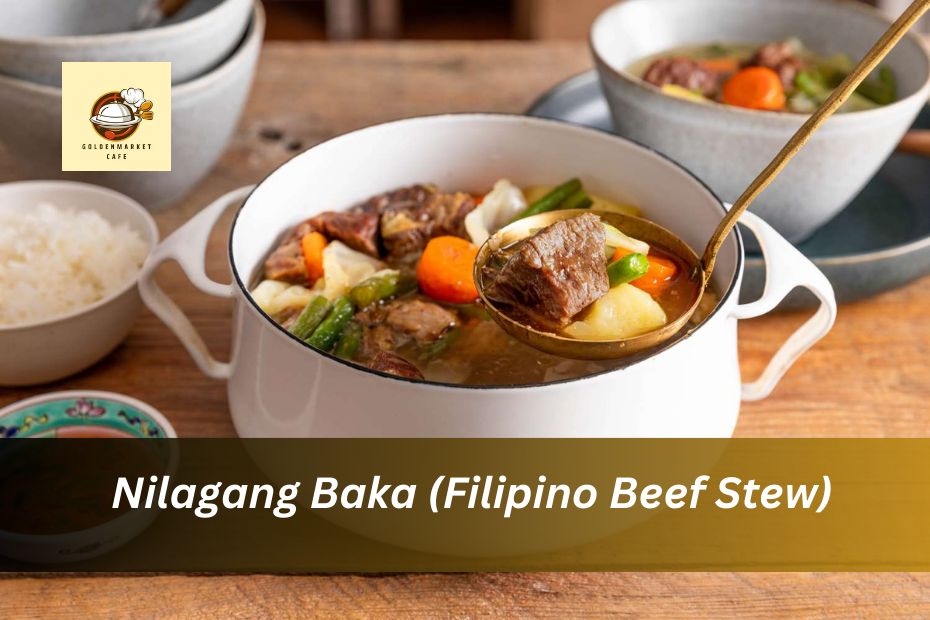All you need to do to make this filling one-pot dinner is cook everything over low heat. The ingredients are year-round, but on cold days, when the kitchen is heated by the stockpot, nilagang baka is the perfect dish. This dish is quite comforting, particularly when paired with steaming rice.
One of the best things about this traditional Filipino cuisine is that it can be made with the simplest ingredients no matter where you are in the globe.
What Is Nilagang Baka?
Beef nilaga, also known as nilgang baka, is a Filipino stew made of soft beef cubes cooked with potatoes, carrots, and leafy greens in a transparent broth. The richness of the meat, together with some garlic, onions, and patis (fish sauce) add savory flavors.
The word “boiled” in Tagalog refers to the process of simmering meats, fish, or vegetables in water or transparent broth. Cooking can be done on the stovetop for a few hours (as in this recipe) or in a deep stockpot over a low simmering fire.
What Does Nilagang Baka Taste Like?
Because there are many tablespoons of patis (fish sauce) added to the soup, nilagang baka has a tinge of salty. Doreen G. Fernandez, a food historian, claims that because Filipino food is consumed against the tasteless backdrop of rice, this particular saltiness is a desire among Filipinos. Usually served simply cooked, rice complements salty sauces well.
Fernandez says the best patis are often fragrant and amber in color, with no hint of fishiness. I buy fish sauce from internet retailers or Asian stores.
What Kind of Beef to Use
Beef nilaga typically calls for beef chuck or stew meat. If available, you can use beef shanks which have rich marrow in the middle of the bone (this type of beef nilaga is called bulalo).
Beef has become pricey in the last few years, so I mix up the beef cuts I use for nilaga, using both stew meat and beef short ribs.
Great for Beginners
This is one of the easiest Filipino all-in-one meals to prepare. When friends who are new to Philippine cooking want to learn a recipe, this nilagang baka is the dish I recommend.
When I have time during weekends, I cook the meat until it is incredibly tender, then I freeze the mixture for another day. Before a busy weeknight, I can take it out of the freezer, thaw it, and reheat. I add the vegetables at the end of cooking.
Easy Swaps and Substitutions
You can swap up to 4 cups of the water for beef stock or broth for more depth of flavor. Sweet potatoes are a nice addition or can be swapped for the potatoes in the recipe. For the greens, you can use Napa cabbage or bok choy in place of the green cabbage.
The vegetables in this recipe are flexible, and you can increase the quantity and variety of according to what’s in season or your preference.
Ingredients
- 2 pounds beef chuck stew meat (cubed), or beef sirloin, cubed
- 2 pounds beef short ribs
- 1 teaspoon baking soda
- 2 tablespoons vegetable oil
- 1 large white or yellow onion, chopped
- 2 cloves garlic, minced
- 2 green onions, chopped, white and green parts separated
- 10 cups water, or enough to fully cover the meats and vegetables
- 1 tablespoon fish sauce, like Red Boat
- 2 medium yellow or white potatoes, (5 to 10 ounces each), peeled and quartered
- 1 medium carrot (about 3 ounces), peeled and sliced
- 8 ounces green beans, trimmed and cut into 2-inch pieces (about 2 cups)
- 1/4 pound green cabbage, cut into 8 wedges
- 1/2 teaspoon kosher salt
- 1/4 teaspoon ground black pepper
For serving
- 4 cups steamed rice, optional
- 1/4 cup fish sauce
Method
-
Prepare the beef:
Wash the beef in cold water. Pat dry with paper towels.
Add the beef stew cubes and the beef short ribs to a large mixing bowl. Sprinkle the baking soda all over the meat, making sure to spread all around evenly. Let the baking soda marinate for 30 minutes. This will help tenderize the meat.
-
After exactly 30 minutes, wash off the baking soda from the beef cubes and pat dry with paper towels. Set aside.
:max_bytes(150000):strip_icc():format(webp)/SimplyRecipesNilagangBakaMethod-1-f2551013f11a4faaa4c26d393a1a957e.jpg)
:max_bytes(150000):strip_icc():format(webp)/SimplyRecipesNilagangBakaMethod-2-fb8924e7b8954b12a507c4f070d13686.jpg)
-
Cook the nilagang baka:
Add the oil to a large stockpot over medium heat. When the oil is hot, add the onion, garlic, and white scallions and sauté until fragrant, about 2 minutes.
Add the beef followed by the water. Add the fish sauce and stir to combine. Cover and cook over medium heat, simmering the beef until soft and tender, about 2 hours. Pierce the beef with a fork—it should be fall off the bone tender.
SIMPLE TIP!
When I am in a rush, I transfer the beef, broth, garlic, and onions into a pressure cooker and cook at high pressure for 45 minutes, using a natural release. I simmer the vegetables separately in a medium pot and add them to the cooked meat before serving.
:max_bytes(150000):strip_icc():format(webp)/SimplyRecipesNilagangBakaMethod-3-8e84f6605806412295d6833cd684fce1.jpg)
:max_bytes(150000):strip_icc():format(webp)/SimplyRecipesNilagangBakaMethod-4-9b193f717f9f46048e06a0084f089dea.jpg)
:max_bytes(150000):strip_icc():format(webp)/SimplyRecipesNilagangBakaMethod-5-16cbbe586c1c449da6ef91a39e54ba62.jpg)
-
Cook the vegetables:
Add the potatoes and carrots and stir. Continue cooking until the vegetables are tender, about 15 to 20 minutes. Add the green beans and cabbage and mix well.
Cover the pot and continue cooking until the greens are tender, about 10 minutes.
Season with salt and pepper.
:max_bytes(150000):strip_icc():format(webp)/SimplyRecipesNilagangBakaMethod-6-42a0e23dd34a4bb9abe3fbd449ae4a44.jpg)
-
Serve:
Ladle the meat, vegetables, and broth into a large tureen or soup bowl. Sprinkle the scallion greens on top for garnish. Serve piping hot with steamed rice and a side of fish sauce. Diners can use the fish sauce to adjust the flavor and saltiness of the stew.
FAQ
